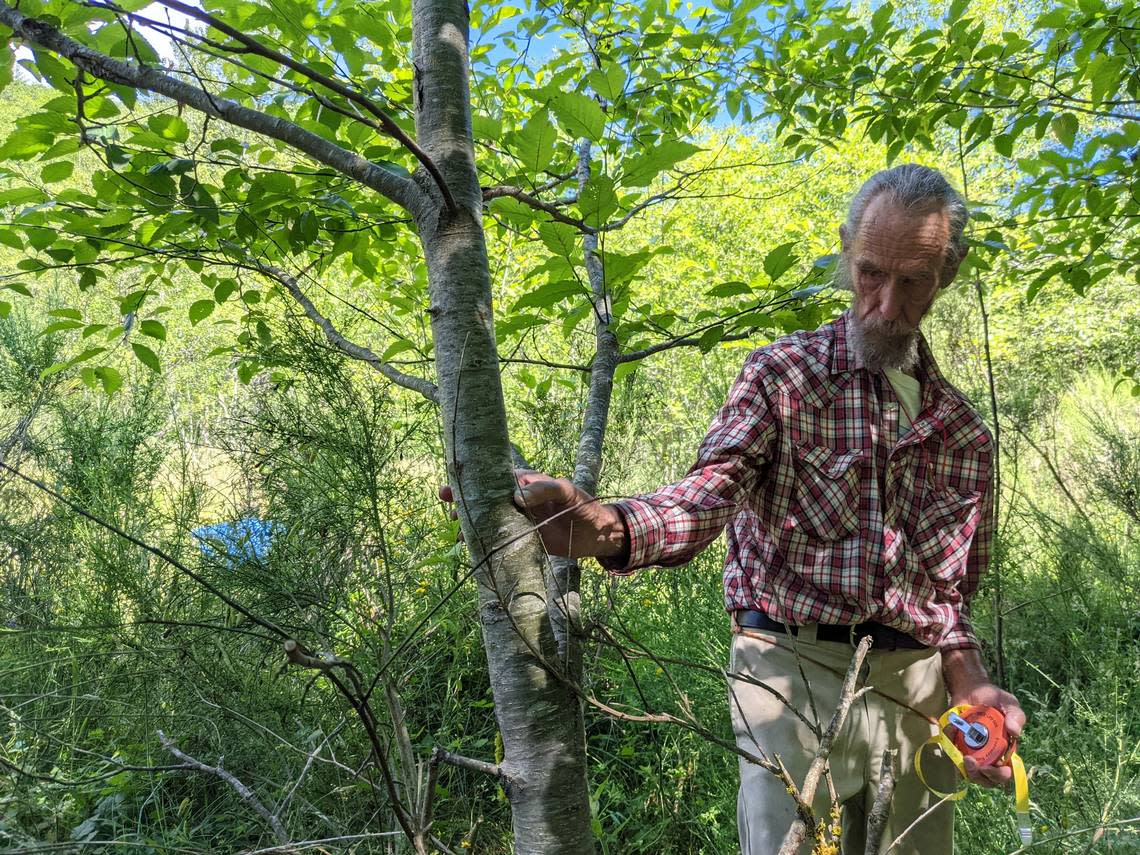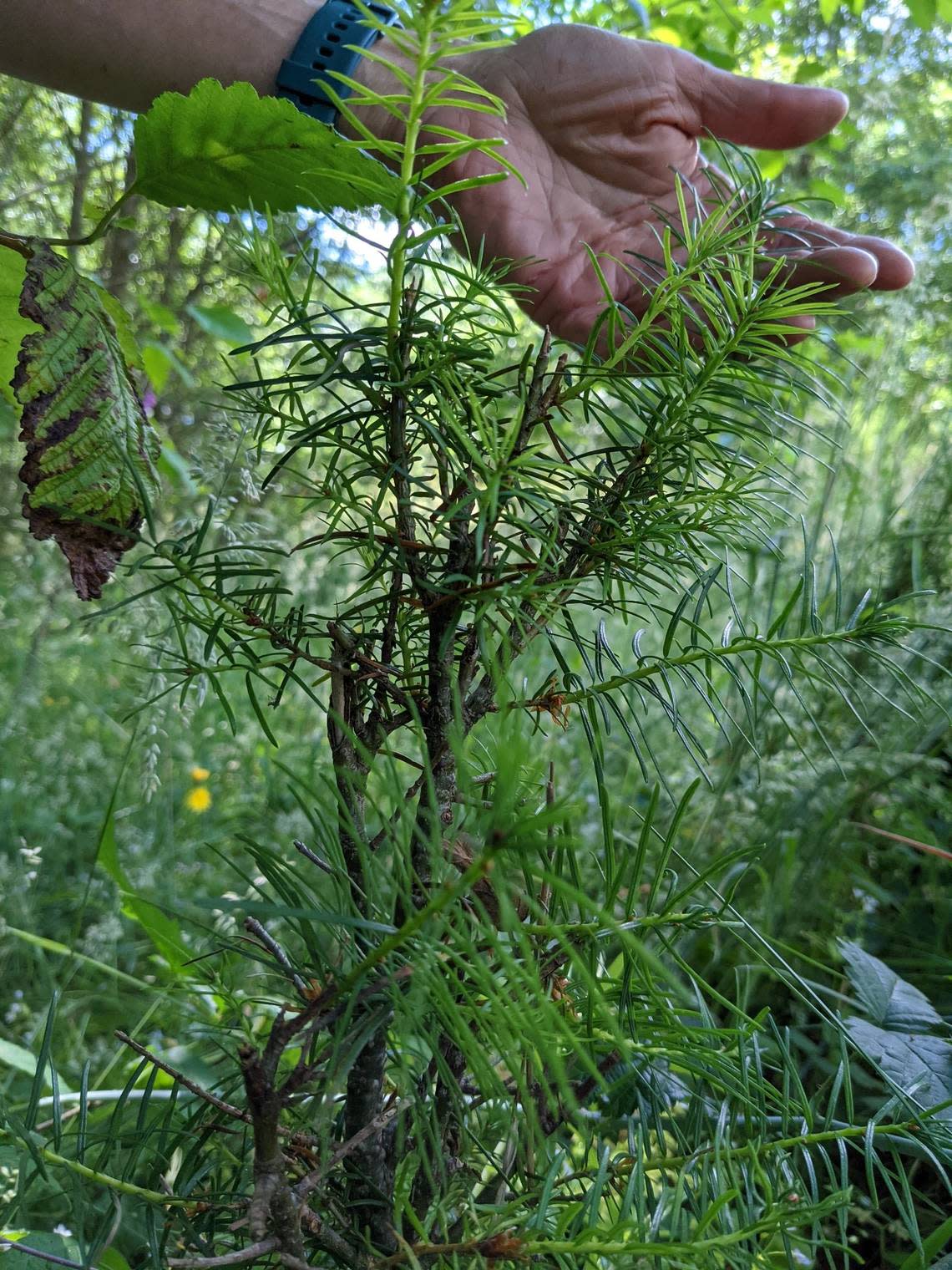Renowned scientist returns to Mount St. Helens year after year. Here’s what she’s finding
Virginia Dale, a renowned scientist with local ties, has again returned along with her ecological research team to sites catastrophically destroyed in the May 18, 1980 eruption of Mount St. Helens.
The team in late July found more indicators supporting Dale’s belief that a conifer forest will eventually emerge, a future landscape that would closely resemble what was once before the explosion.
Red alder is a pioneer species that establishes readily in open areas left after nature’s disturbances. Mount St. Helens’ lateral blast and avalanche flows were certainly disturbances of the highest order. Red alder is present in most of the 62 plots that Dale and her team are studying. Alder is a nitrogen fixer and provides valuable nutrients to the soil, fostering growth of conifer seeds blown on the wind to the damaged areas.
Dale’s team, which included leading scientists, mentoring students and volunteers, found Douglas fir and hemlock, two common Washington conifers, on some of the plots. Three species found in understories of conifer forests also have been found in the studied plots, strengthening the opinion that a conifer forest will return to St. Helens. Those species are Claytonia sibirica (pink purslane), Rubus leucodermis (whitebark raspberry) and Prunella vulgaris (woundwort or blue curls of the mint family Lamiacene).

Decades of research
Dale started her research in the early 1980s with 103 plots established as part of an effort with her then-husband, A. B. Adams.
Her recurring visit every five years for 40 years was interrupted for two years until 2022 due to the COVID-19 pandemic. Back now, Dale made her pilgrimage to St. Helens this last week of July.
Dale is respected worldwide for her contribution to the International Panel on Climate Change that shared the 2007 Nobel Peace Prize with Al Gore. It has been her ecological mission to return periodically to hike and record data from seeded and unseeded plots covering a six-mile-long stretch between the north fork of the Toutle River and Castle Creek and also between Castle and Coldwater lakes.
The blast from St. Helens destroyed all organic matter and living organisms as it moved through forested areas, toppling and burying trees in its path, coming to an end near valley walls of the north fork of the Toutle River with clumps of organic material, soil and surviving plants. The debris-avalanche deposit provided an opportunity to examine primary succession.
As a young scientist living in Washington state with a doctorate from the University of Washington, Dale was on the first team of biologists who entered the red zone at Mount St. Helens after the big blast on May 18 more than 42 years ago. She has been studying the vegetation reestablishment ever since. It has been her life’s work in what she has called a “living laboratory.” Dale has recorded 247 species over the years and said, “I hope to find that many this time.”
Dale, who now lives in Tennessee, is affiliated with the Oak Ridge National Laboratory and is an adjunct professor at the University of Tennessee. She was joined at St. Helens by her husband, Keith Kline, a noted scientist in his own right, who also is connected with Oak Ridge Lab.
Others on this year’s team included Dr. Robert F. (Bob) Holland and his wife, Ginny, from California, longtime botanists and researchers with experience working for many agencies throughout the west; Elsie Denton, a range management ecologist from Oregon who will be moving to Tennessee this fall to pursue a doctorate in Dale’s program at the University of Tennessee in Knoxville; Brad Hensley, an aerospace engineer from Colorado who is Dale’s son and who recently completed a habitat experience for NASA; Hensley’s fiancee, Erin Swiatek, a sales representative for Deuter Sport in Colorado; Parker Maynard, who will be moving from Michigan to Tennessee to pursue a master’s degree in Dale’s program; and Wendy Adams, of Washington, D.C., daughter of A. B. and Virginia, who has helped her mother at St. Helens on several occasions. Al and Candy Holland, Californians, managed the base camp and prepared meals for team members. Al, brother of Bob Holland, utilized skills gained from river-running tours he led. Bob and Al are cousins of A. B. Adams. The team was well organized, under Dale’s plan, and up for the tasks.

Hunting for plants
On the first day, a plot team led by Hensley left ahead of the rest to locate the plots and mark them. That was not necessarily an easy task because the team was traversing landscape that hadn’t been hiked for seven years and was overgrown.
Using a GPS unit, the plot team moved in the correct direction to the beginning of the series of plots. One team member marked ribbons on trees along the way to guide the vegetation team that followed. Once Hensley and his group found the plot, they looked for a long piece of steel rebar driven into the ground, which marked the center of the plot. They tagged it. One member measured the amount of canopy cover. Another took soil samples. For documentation purposes, another team member took photos looking west-to-east and south-to-north with the plot number shown.
The initial 103 plots represented a variety of geological and topographic conditions on the debris-avalanche deposit and were purposely located a considerable distance from adjacent surviving vegetation. Over the years, wind-blown seeds from the existing vegetation drifted onto the barren deposit flow. Forty-one plots were lost over time due to erosion. Each of the circular plots is 250 square meters. The plots are spaced at 50-meter intervals along transects between Castle and Coldwater lakes and between the Toutle River and Castle Creek. Once finished with a plot, the lead team used a measuring tape to find the next plot and repeated their assigned tasks.
The vegetation team found each marked plot. Knowing the area of each plot, the team used a tape to measure 8.9 meters (the radius) from the center and marked the edges along each circle’s circumference. Then, they performed their tasks to identify species within the circle and calculate the percentage of coverage in each plot of those species. The team members walked carefully through the plot so as not to trample plants and yelled out the Latin names for the various species.
Dale sat on a camp stool outside the circle with a clipboard containing each plot’s listed species. She recorded the team members’ call-outs. When there were some species previously recorded on a particular plot that weren’t called out, Dale asked team members to confirm that finding. Finally, she asked them for their estimation of the coverage of the recorded species. They responded, “Trace, 5 percent, 20 percent, 30 percent,” and so on.
Sometimes there would be disagreements regarding a plant’s identity, and it would be uprooted, put into a plastic bag and taken back to base camp on the edge of the debris-avalanche deposit to have an expedition botanist make a decision, based on various references. On Monday, July 25, the scientist in camp assigned that task happened to be 73-year-old Bob Holland, whose longtime study of Mount St. Helens goes back to helping A. B Adams.
“I probably know more than 5,000 plants I can identify,” said Holland. “And I probably have forgotten 2,000 plants that I knew in Ohio before I moved out West.”

Holding a grass sample found in one of the plots, he identified it as Elymus, a species that prefers wetness. He wrapped the specimen in newspaper for archiving purposes. The team has found ponds on some plots and moisture-loving plants.
The group’s mission was sometimes difficult and somewhat hazardous when the teams had to ford the Toutle River to get to the plots between Castle and Coldwater lakes. Someone ventured across and set up a rope system to help the others get across safely. Then, they scaled a cliff to get to the plots and accomplished their tasks.
Dale’s team proved to be diligent and resourceful in continuing her work that has become the most extensive plant study of any volcano, or mountain for that matter, in North America. She wants to see it go on for many more years.
“I want to keep doing this as long as I can, “ Dale said, “but I’m hopeful that Elsie (Denton) will take it over.”
Denton said, “That seems to be the plan, and I’d like to bring more statistics and analysis into the next phase. For comparison, I might want to look at debris-avalanche deposits at other volcanoes.”
Hopefully, funding will be there. Dale has been listed as a “principal investigator” through funding from the National Science Foundation. She has also received funding from other scientific sources, including the National Geographic Society, Earthwatch and the Center for Field Research of Belmont, Massachusetts.
A conifer forest will return to Mount St. Helens in its own time. On a debris-avalanche deposit totally devoid of life after May 18, 1980, plants are slowly taking hold of the landscape. The study of plant recovery continues on what once was a lifeless landscape, now a “living laboratory” that is Mount St. Helens.
Jim Erickson covered the 1980 eruption of Mount St. Helens for The News Tribune and published a book chronicling the 40th anniversary in 2020, offered by The History Press.
